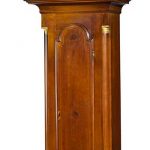Martin Cheney began his business in Vermont but moved to Montreal about 1809 and spent the rest of his life in Canada where he operated a shop in Montreal from 1809 to 1830. He made both movements and cases, wall and tall case clocks and banjo clocks. He was the son of Benjamin Cheney, who trained him and brothers, Ashel, Elisha, and Russell, in the manufacture of both wooden and brass clockmaking. Martin was born in 1778 in E. Hartford Conn and moved to Montreal Canada in 1809. Reference: National Association of Watch & Clock Collectors Inc
Exceptional Federal Cherrywood Tall Case Seven-Tune Musical Clock, Martin Cheney, Windsor, Vermont, Circa 1809 dial inscribed M. Cheney / WINDSOR and the tunes: St Mary. = Marquis of Granby. = Duke of Argyle = Mrs Casey = New Jersey = Scotch Luck = Pleasures of Solitude. Height 105 in. by Width 26 in. by Depth 14 in.
Martin Cheney was one of three sons who learned the trade from their father, Benjamin, in East Hartford, Connecticut. The brothers relocated to southern Vermont around 1800, Martin settling in Windsor, Russell in Putney and Asahel in Royalton. After about nine years, Martin moved north to Montreal where he carried on his business into the late 1830s. The three-train brass musical movement shows the influence of the Cheney family’s Connecticut roots. On the outside, it appears to be a Daniel Burnap movement, with the bulbous pillars, deadbeat escapement and count wheel strike that are generally associated with his work. The ‘Osborne’ dial is made of painted iron and was imported from Birmingham, England. The chimes play seven tunes of 10 bells and hammers, changing automatically at midnight, or manually by hand. The f holes on the sides of the hood are similar to those found on a violin.1
This rare and important Musical Tall Clock descended in the Cutting family of Weathersfield, Vermont and is signed by the maker, “M. Cheney, Windsor,” for Martin Cheney of Windsor, Vermont. A possible original owner may be Jonas Cutting I (1762-1842), whose son, Jonas Cutting II was born in Weathersfield, VT in 1790. Martin Cheney was born in East Harford, CT, the son of the clockmaker Benjamin Cheney (active 1745-1780). He trained under his father and in 1805 moved to Windsor, VT, where he established his own clock making business. His life and career are discussed in Vermont Clock and Watchmakers, Silversmiths and Jewelers, by Lilian Baker Carslisle. According to the author, “Martin Cheney, clockmaker and silversmith, was born in 1778 in East Hartford, CT, the son of Benjamin and Deborah Cheney…His father was one of New England’s finest clockmakers and worked from about 1745 to 1780.
Benjamin Cheney and his brother Timothy Cheney were especially noted for their majestic tall clocks with wooden works cased in carved cherry wood cases…Martin, who probably served his apprenticeship with his father and uncle, came to Windsor about 1803 and on December 5 of that year married Fanny Patrick in that town.” The author noted the explosion of sophisticated architecture and furniture that filled Windsor, “The Birthplace of Vermont”, after 1800; “The constitution of Vermont was drawn up in Windsor and in this town many of the historic men of Vermont met and did business. With its growing power, the town attracted residents of a cultivated taste. Its architecture was the best of the times and the homes and taverns displayed spacious open porches, stately pillars, arched and corniced ballrooms for dancing – all early signs of advancing luxury. To embellish and dignify their splendid homes, the residents demanded furnishings of equal magnificence and there was a ready demand for the choice and elegant clocks made by Martin Cheney. Some of the clocks told not only the hours, but the days of the month and changes of the moon, and some of them had musical accompaniments with a tune for every day of the week, and a special meditative air for Sundays.”
With the complexity of the musical movement and inlaid decorated case, this clocks stands as a prime example of the products supplied by the sophisticated craftsmen that were drawn to Windsor during the Federal era. The clock’s size, complexity of movement, intricate decoration to the case, all support the clock’s significance from the day it was made until today. Interestingly, Martin Cheney only stayed in Windsor for five years, from 1805 to 1809, supporting a narrow manufacture date of these few years. After leaving Windsor, Cheney moved his business to Montreal, Canada, where his last known advertisement appeared in 1827.
Sold for 87,500 USD at Sotheby’s in 2018
A very rare, distinctive and complete C.1820s banjo clock by renown Montreal clock- and watchmaker Martin Cheney. Signed on dial and movement. 8-day, time only brass weight-driven movement. The unusual design of this case is unique to Cheney and Quebec. A remarkable example in complete condition.
Sold for CA$6,500 at Miller & Miller Auctions Ltd. in 2017



